Your cart is currently empty!
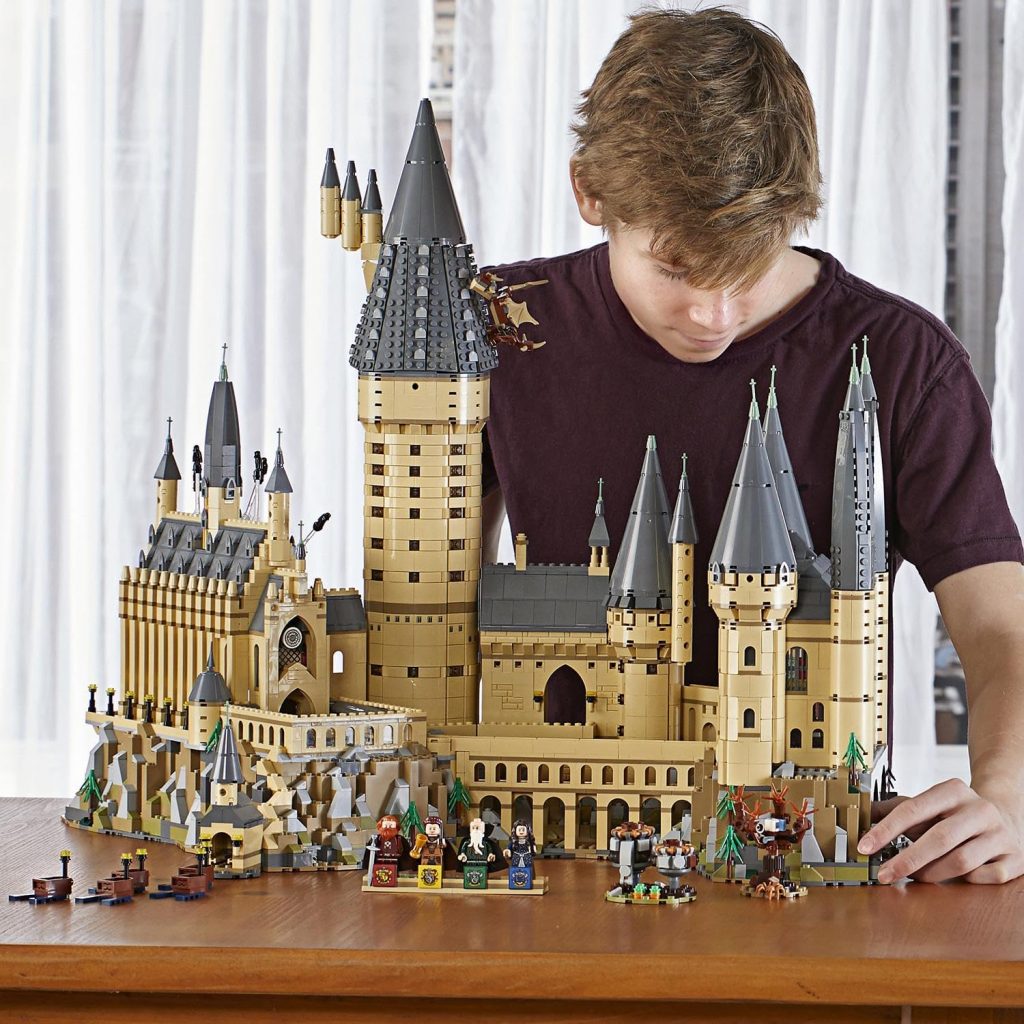
Hogwarts.
LEGO Harry Potter Hogwarts Castle
The LEGO Harry Potter Hogwarts Castle (Set 71043)
A monumental homage to one of fiction’s most beloved architectural marvels. Since its release in 2018, this set has captivated both dedicated LEGO enthusiasts and fervent Harry Potter fans, fulfilling a long-standing desire for a truly grand representation of the School of Witchcraft and Wizardry. This review delves into every facet of this colossal build, from its intricate construction to its impressive display presence, to determine if it truly casts a spell on collectors.
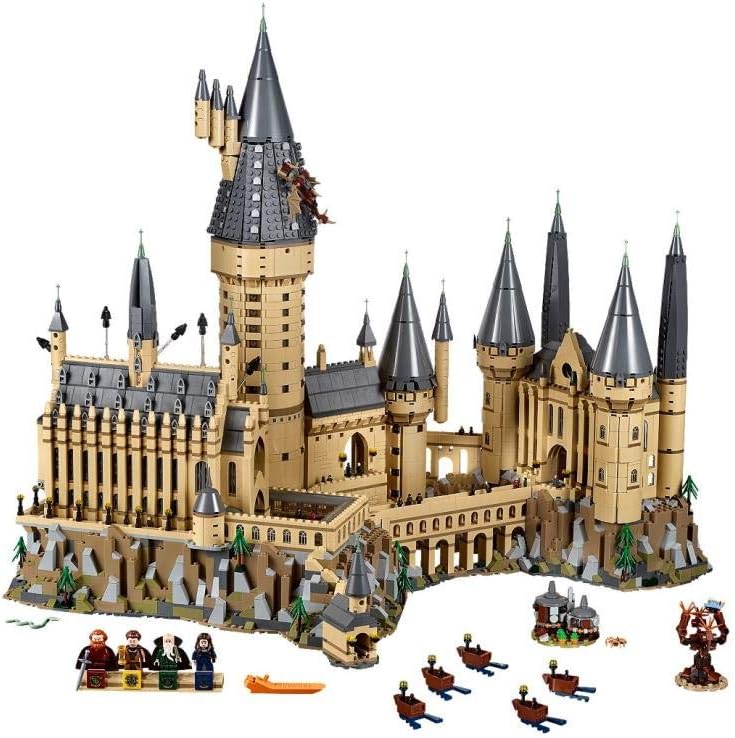
Unboxing a Magical Behemoth
The initial encounter with the LEGO Harry Potter Hogwarts Castle 71043 immediately signals its extraordinary scale. The sturdy box, weighing a substantial 16.5 lbs (7.5 kg), is filled to the brim with parts, meticulously organized. To aid in structural integrity and prevent damage, the first 13 bags, along with the instruction manuals, are thoughtfully placed in a smaller, unmarked box within the main packaging. The sheer volume of components is staggering, with bags numbered sequentially from 1 all the way to 37 or even 39, a testament to the extensive building journey ahead. This meticulous organization and the sheer number of elements immediately elicit a “Wow!” reaction, setting high expectations for the building experience.
At a whopping 6,020 pieces, the Hogwarts Castle 71043 was, at its release, the second-largest LEGO set ever produced, surpassed only by the UCS Millennium Falcon. This impressive piece count, coupled with its substantial weight, instantly conveys the monumental scale and ambition of the model. The unboxing experience, therefore, is not just about opening a product; it’s the first step in an immersive journey into a complex architectural project. This immediate communication of the set’s grandeur and premium nature effectively sets the stage for a significant and rewarding building endeavour, signalling to the enthusiast that this is no ordinary LEGO assembly.
Beyond the sheer volume, the set introduces a variety of unique and new elements that contribute to its intricate detailing. These include specialized window arch parts and transparent printed glass components. These new elements are crucial for achieving the granular details and greater fidelity in window creations at the set’s nano figure scale, allowing for a level of architectural accuracy that would otherwise be impossible.
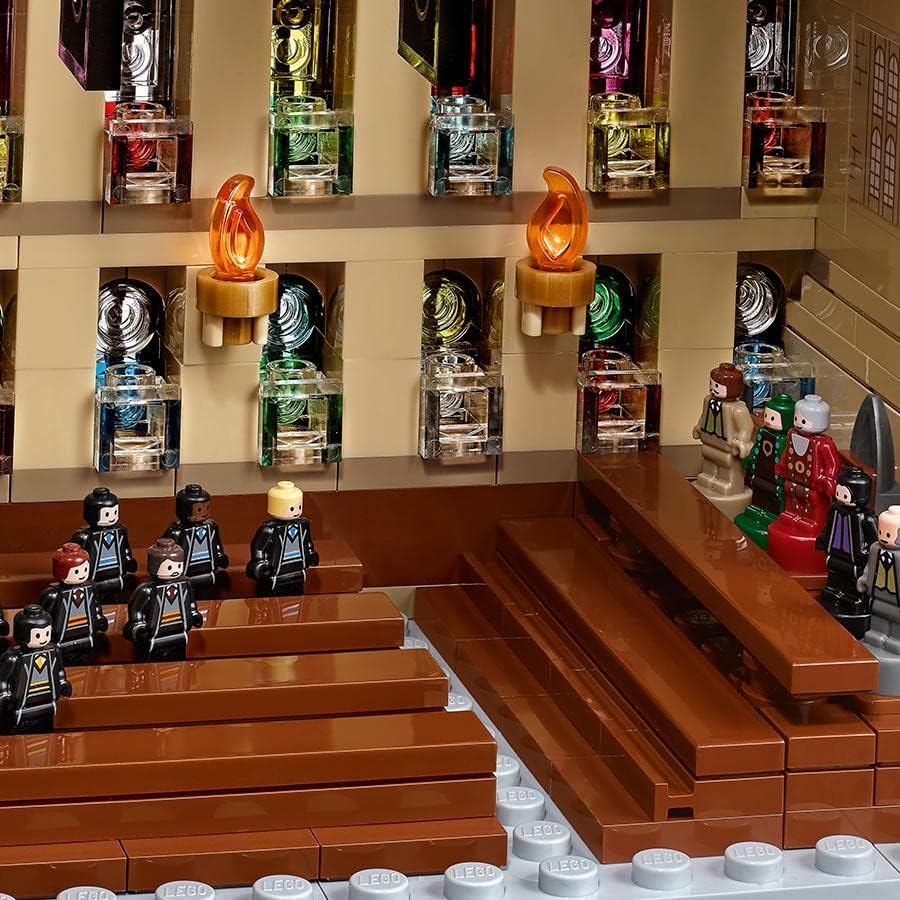
Building Experience & Complexity
The construction of the LEGO Hogwarts Castle is designed to mirror Harry Potter’s journey through the school, commencing with the iconic Black Lake and its boathouse. The entire build is thoughtfully divided into two independent halves, a feature that not only manages the colossal piece count but also facilitates collaborative building, making it a memorable and fun activity that can even draw in non-LEGO enthusiasts.
The structural foundation of the castle is a masterclass in engineering. A large Technic frame forms the initial base, providing crucial support for the substantial combined weight of the cliffs and buildings. While this initial assembly is relatively straightforward, its robust nature ensures the model’s stability, with all Technic elements ingeniously concealed as the build progresses. This robust internal framework provides surprising strength to what might otherwise be a largely hollow structure, ensuring the completed model can be moved without concern for structural integrity.
The building process itself is a rich tapestry of innovative techniques, showcasing advanced LEGO engineering. For instance, the creation of rounded structures, such as the Marble Staircase Tower, employs methods strikingly similar to those found in the renowned LEGO #21309 NASA Apollo Saturn V set, utilizing brackets and curved wall panels to form consistent cylindrical shapes. The iconic stained-glass windows, particularly those in the Great Hall, are “ingeniously assembled” using a mosaic of 1×1 and 1×2 transparent plates, attached to trans-clear headlight bricks, with dark bluish grey grille tiles forming the intricate “came strips”. This technique creates a remarkably vibrant and translucent effect, adding significant visual depth. Furthermore, the set’s many spires and conical roofs are crafted with clever part usage, including 3×12 wedge plates that slot together to form smooth conical shapes, and 1×1 round tiles with vertical shafts for intricate central towers. The rugged cliffs surrounding Hogwarts are built using large rock elements, but the “liberal use of slopes in varying colours” cleverly disguises repetitive shapes, creating a “remarkably realistic” and irregularly shaped base. To assist with the sheer complexity, “odd-coloured pieces in lime green, orange, medium azure, and red” are strategically placed in non-visible interior sections, serving as visual guides for accurate brick placement.
This intricate building process is more than just assembly; it functions as an immersive educational experience in advanced LEGO engineering. The designers faced the formidable challenge of translating the intricate Gothic and French Renaissance architecture of Hogwarts into a micro-scale model while ensuring both structural integrity and aesthetic fidelity. The innovative use of Technic for internal support, hinge plates for complex angles, and creative part applications for organic shapes and detailed features showcases a remarkable level of design sophistication. For experienced builders, this means the set offers profound engagement beyond mere fan service. It stands as a testament to LEGO’s evolving design prowess, providing a valuable learning opportunity in advanced construction techniques and demonstrating the artistic and engineering potential of the medium. It elevates the set from a mere collectible to a legitimate architectural model.
While largely engaging, the build is not without its minor challenges. Constructing the extensive rock faces and cliffs, though visually impressive in the end, can become “somewhat repetitive” due to the nature of the elements. Some builders have also reported difficulties with instruction clarity at times, particularly when adding wedges to the rock face or assembling the modular roof slates of Dumbledore’s tower, making it easy to make mistakes. Additionally, securing the wedge plates for smooth conical roofs, like Dumbledore’s tower, can be tricky, as they tend to leave gaps or pop off.
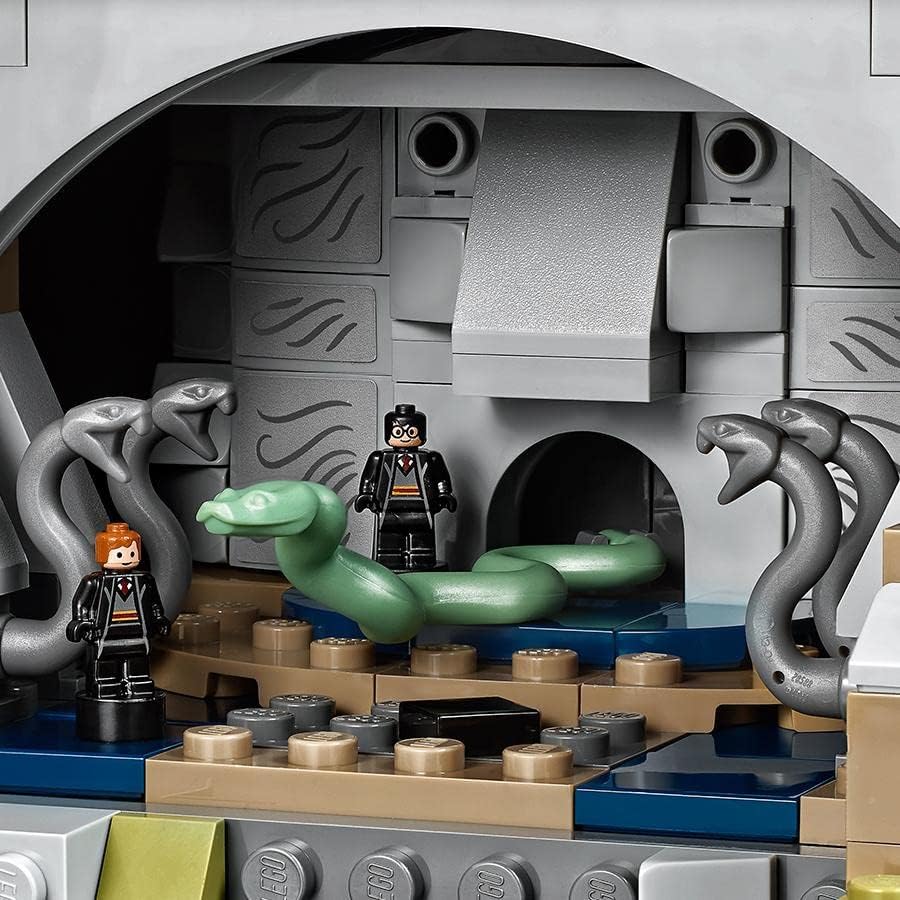
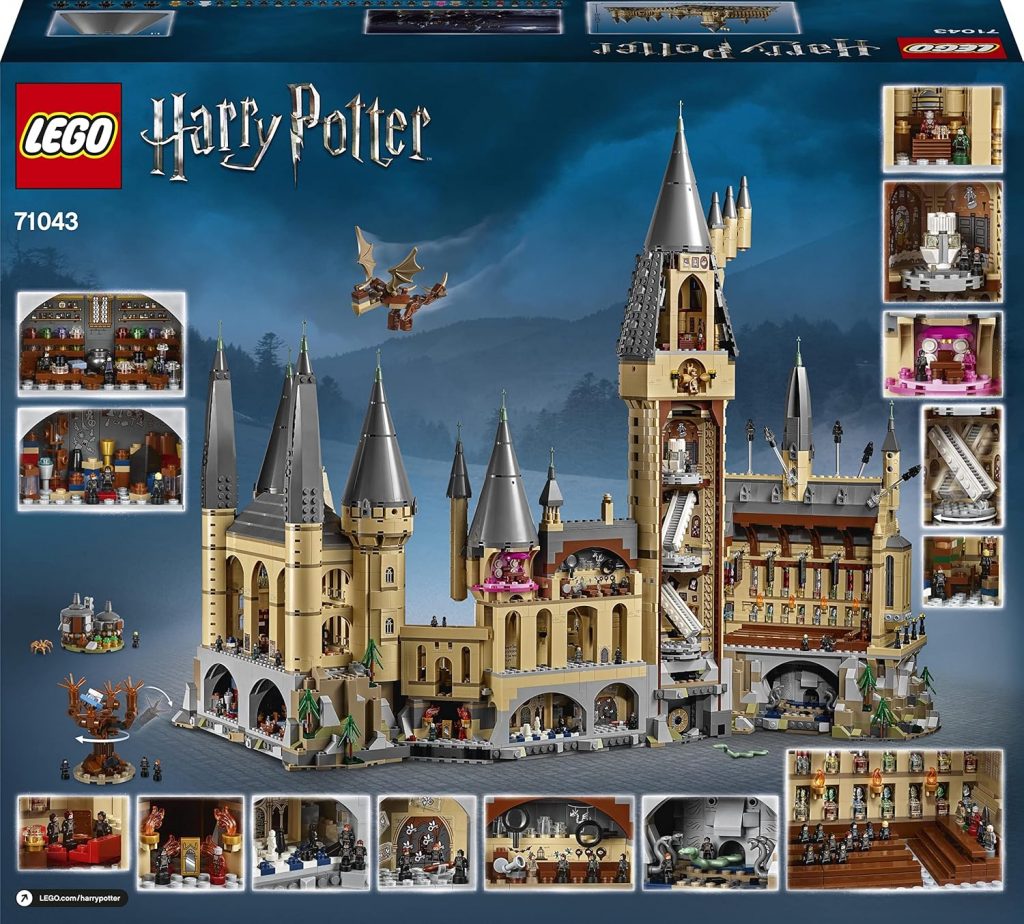
A Castle Reimagined
The LEGO Hogwarts Castle 71043 is a triumph of architectural recreation, blending traditional Gothic and French Renaissance styles to capture the iconic look of the castle as it appears from Harry Potter and the Prisoner of Azkaban. Its completed dimensions, measuring 69cm wide and with the Marble Staircase Tower reaching over 58cm in height, make it an undeniably “tremendous display piece” that commands attention. Its authenticity to the source material is a significant strength, making it instantly recognizable to fans.
Exterior Detailing
The exterior of the castle is where its aesthetic brilliance truly shines. The rugged surroundings are meticulously crafted, with large rock panels forming the basis of the cliffs. These are cleverly disguised and detailed using a range of different slopes, resulting in a “remarkably realistic” and irregularly shaped landscape. Miniature pine trees add a welcome splash of colour to the rocky base. The set thoughtfully includes the boathouse, complete with five small, enchanted boats, each featuring a tiny lantern and ingeniously using a reddish-brown window frame for its hull.
The Great Hall’s exterior is “intricately detailed” and “looks perfect when compared with the movie”. Vertical columns flank the stunning stained-glass windows, which look “absolutely spectacular when lit from inside”. A large clock, represented by a 2×2 round tile with a sticker, hangs prominently above the entrance. The roofs are adorned with pearl silver teeth forming dormer windows, and three spires protrude with “brilliant proportions”. A particularly delightful detail is the inclusion of tiny Dementors, represented by Darth Sidious hologram elements on trans-clear bars, effectively conveying the impression of flight around the roof. A long viaduct, scaled perfectly to the micro-figures, connects the courtyard in front of the Great Hall with the Viaduct Entrance, strikingly resembling a Roman aqueduct. The Viaduct Courtyard, while scaled down, integrates well with the dark tan cliffs.
Interior Detailing & Iconic Locations: Accuracy and Strategic Compromises
The interior of Hogwarts Castle is “equally detailed” , serving as a “greatest hits” collection of iconic movie moments, though sometimes with strategic compromises in placement due to the micro-scale. This design approach highlights a deliberate choice by LEGO: to create an overwhelmingly impressive and movie-accurate
exterior and to include as many iconic interior locations as possible, even if their precise placement or scale within the micro-model isn’t perfectly faithful to the films. This decision is driven by the micro-scale and the need to deliver a cohesive, visually stunning display piece. The interior functions more as a visual narrative and display element for fans, rather than a geometrically perfect internal layout. For a collector-focused review, this means setting appropriate expectations: while the exterior is a monumental achievement, the interior, though rich in detail, serves primarily as a visual narrative and display element rather than a strictly accurate or highly functional play space. The set’s core value lies in its breath-taking visual representation of Hogwarts as an architectural marvel, making it a prime display piece.
The Great Hall interior features colourful house banners, candles clipped to the walls, and a wonderful vaulted ceiling. The house points counter is a delightful inclusion , as is a sticker depicting Dolores Umbridge’s educational decrees. However, the windows above the high table appear “awkward” due to the stark contrast with the brick-built stained glass.
The Chamber of Secrets, located in the basement, is praised for its “enormous statue of Salazar Slytherin’s face” and four carved serpents, from which the Basilisk emerges. Tom Riddle’s diary is also present. The round entrance door is a sticker and cannot open. It is important to note that its placement is not movie-accurate due to design limitations.
Dumbledore’s Tower, a wide structure, houses the second-floor girl’s bathroom, Dumbledore’s office, and the Grand Staircase. Dumbledore’s office relies heavily on stickers for details like Fawkes’ perch, the Sorting Hat, and the Sword of Gryffindor. The Grand Staircase is recognizable but not perfectly to scale or mirroring the movie design.
Scenes from Philosopher’s Stone are recreated in miniature, including the chamber of winged keys, a detailed chess set (nano-figure scale), and the Mirror of Erised. However, some key elements like Fluffy the three-headed dog and Professor Quirrel are omitted, and room placements are not entirely accurate. The Room of Requirement is furnished with jumbled furniture and a Vanishing Cabinet, mirroring its appearance in
Half-Blood Prince, though its placement is also not movie-accurate.
Professor Snape’s Potions Classroom is meticulously designed with vibrant stickers depicting flasks and potions, along with cauldrons. The potions are not at nano-figure scale, and the room’s location is not true to the film. Dolores Umbridge’s Office is instantly recognizable by its lurid pink walls and brick-built 1×1 round plates representing her decorative cat dishes. The Gryffindor Common Room and Library areas are well-designed, featuring red settees, a fireplace, and an impressive bookshelf. The common room’s placement within the Great Library section is noted as somewhat out of place.
The Whomping Willow and Hagrid’s Hut are charming standalone nano-figure builds adding to the scenery. Hagrid’s Hut features a brilliant pumpkin patch and the giant spider Aragog. The Whomping Willow includes a tiny, buildable blue Ford Anglia caught in its spinning branches. Notably, a Hagrid nano-figure is missing, which feels like an oversight given the inclusion and detail of Hagrid’s Hut.
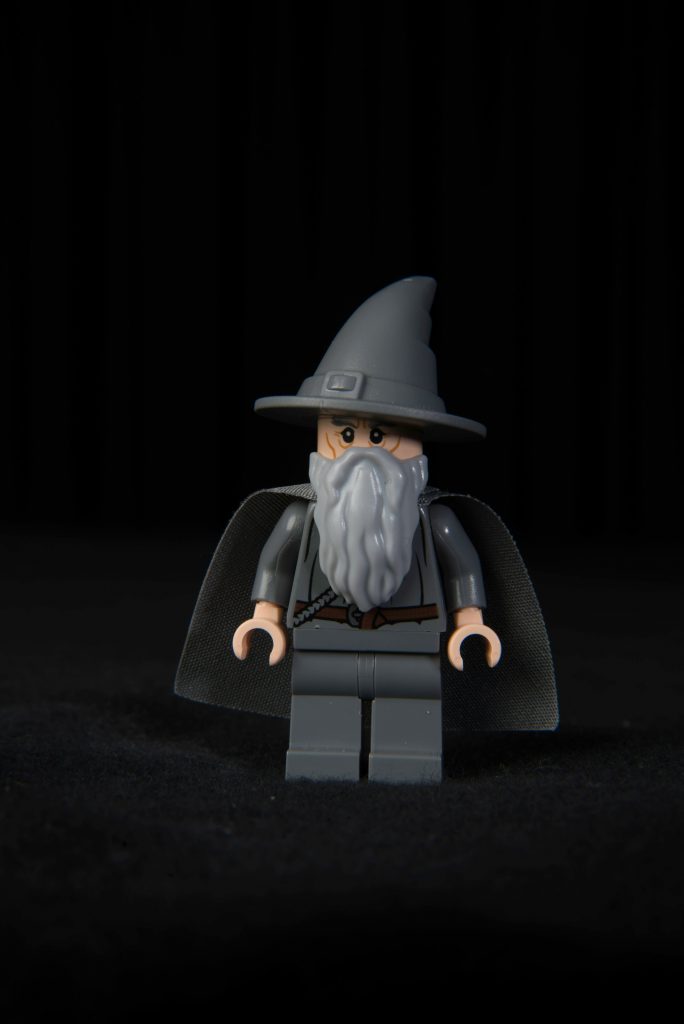

Key Hogwarts Locations: A Micro-Scale Masterclass
| Location | Design Highlights | Accuracy/Notes |
| Great Hall (Exterior) | Intricate detail, vertical columns, stunning stained glass (especially when lit), large clock sticker. | Highly movie-accurate; visually spectacular. |
| Great Hall (Interior) | Vibrant house banners, wonderful vaulted ceiling, house points counter, Umbridge decrees sticker. | Faithful to film details; windows above high table appear awkward. |
| Chamber of Secrets | Monumental Salazar Slytherin’s face, carved serpents, Basilisk. | Visually impressive; round door is a sticker, cannot open; non-movie-accurate placement. |
| Dumbledore’s Tower | Recognizable Grand Staircase, Dumbledore’s office details (Fawkes’ perch, Sorting Hat, Sword of Gryffindor). | Staircase not perfectly scaled/accurate; office heavily relies on stickers. |
| Philosopher’s Stone Challenges | Winged keys chamber, detailed chess board (nano-figure scale), Mirror of Erised. | Captures iconic scenes; missing Fluffy/Quirrel; non-accurate room placement. |
| Room of Requirement | Jumbled furniture, Vanishing Cabinet. | Good detail; non-movie-accurate placement. |
| Snape’s Potions Classroom | Meticulously designed shelves with vibrant potion vials (stickers), cauldrons. | Detailed; potions not nano-figure scale; non-movie-accurate placement. |
| Whomping Willow | Articulated branches, tiny Ford Anglia caught within, hidden Shrieking Shack passage. | Excellent motion and detail. |
| Hagrid’s Hut | Brilliant pumpkin patch, Aragog spider, ramshackle stone texture. | Charming and detailed; missing Hagrid nano-figure. |
| Moving Staircases | Two staircases mounted on turntables, allowing direction change. | Innovative function; absence of surrounding doorways. |
Unlocking the Magic: Functional Features & Play Potential
While primarily designed as a display piece, the Hogwarts Castle set incorporates several ingenious interactive elements that add a layer of dynamic engagement, allowing for a degree of “play” at the micro-scale. This set occupies a unique “interactive display piece” niche. The functional elements are present, but they are often simplified or symbolic, designed to evoke memorable movie moments rather than facilitate extensive, realistic play. The micro-scale, while limiting traditional play scenarios, enables the inclusion of a vast array of iconic locations within the model. For the discerning enthusiast, this means managing expectations regarding playability. While there are engaging interactive features, the set’s “play” is more about visual exploration, scene recreation with micro-figures, and the satisfaction of building a detailed model, ultimately enhancing its display value rather than offering deep, hands-on interaction in the traditional sense. It caters to a collector’s desire for both static beauty and subtle dynamic elements.
Interactive Elements: A Nod to Playability
One of the most iconic features of Hogwarts, the moving staircases, are cleverly recreated within the Marble Staircase Tower. Two staircases are mounted on turntables, allowing them to spin and change direction, mimicking their magical movie counterparts. However, a minor point of disappointment is the absence of surrounding doorways for these staircases, which detracts slightly from their functional realism.
The infamous Whomping Willow is a standalone build that offers interactive motion. It is constructed with articulated branches (using Exo-Force robot arms and new stalk parts) designed with motion in mind, allowing the tree to turn and its branches to be positioned. A tiny, buildable blue Ford Anglia car can be placed within its spinning branches, recreating a memorable scene from the films.
The circular entrance to the Chamber of Secrets is built with a complex Technic structure. While some might initially expect the door to slide open, it does not, relying on a sticker for its visual effect. Nevertheless, the chamber itself is intricately detailed. A subtle, hidden detail, the secret doorway to the Room of Requirement, is present on a pillar in one of the corridors, adding a touch of discovery for observant fans. Five menacing Dementors are included, and their “flight” is ingeniously simulated by attaching them to trans-clear elements, which then connect to various studs and anti-studs on the castle’s roof and rear, giving the impression they are hovering menacingly.
Included Accessories and Scene Recreation
The set is complete with miniature accessories and scene-specific elements that invite imaginative recreation. Five small enchanted boats, each making “ingenious use of a reddish brown window frame” for its hull, are included for the Black Lake, ready for first-year students. Key moments from
Philosopher’s Stone are represented, including the chamber of winged keys, a detailed chess board with black and white squares and chess pieces, and the final chamber with the Mirror of Erised and a tiny trans-red 1×1 round tile for the Philosopher’s Stone. Hagrid’s Hut features buildable pumpkins in the garden and the giant spider Aragog outside, perfect for planning adventures.
Micro-figure Integration and Scale
The castle is designed at a “small scale which suits the trophy figures”. The inclusion of 27 micro-figures allows fans to populate the vast castle, demonstrating its immense scale and enabling the recreation of iconic scenes within its numerous chambers and courtyards. While some interior details are noted as being “too large for the trophy figures” , the micro-figures generally serve their purpose well in conveying the bustling life of Hogwarts.
Display Piece vs. Play Set: A Clear Distinction
It is crucial to reiterate that while these interactive elements exist, the LEGO Hogwarts Castle is fundamentally designed as a “display piece”. User feedback sometimes hints at a desire for a “bigger version of this set” or “minifig rooms in the back” , indicating a trade-off between display aesthetics and extensive, traditional minifigure-scale play features. The set’s primary focus is on visual accuracy and creating a breath-taking model for admiration, with the interactive elements serving to enhance this display rather than providing deep, hands-on play scenarios.
The Inhabitants of Hogwarts: Figures & Collectibles
The LEGO Hogwarts Castle 71043 employs a clever “dual-scale figure strategy.” The full-size minifigures of the founders serve as premium, highly collectible items, adding significant exclusivity and value to the set, and are clearly designed for display outside the main castle model. Conversely, the micro-figures are perfectly proportioned to inhabit the castle’s interior and exterior, allowing for scene recreation and effectively demonstrating the sheer, imposing scale of the model. This approach avoids the impossible task of creating a minifigure-scale castle while simultaneously maximizing both collector appeal (through exclusive, displayable minifigures) and in-set narrative potential (through micro-figures populating the vast structure). This strategy demonstrates LEGO’s sophisticated understanding of its diverse audience. It caters to collectors who prioritize displayable, exclusive minifigures, as well as those who desire figures that seamlessly integrate with a large-scale model. This dual approach reinforces the set’s identity as both a high-value collectible and a detailed, immersive model, delivering distinct forms of value to different segments of the enthusiast community.
The Illustrious Founders Minifigures
A significant draw for collectors is the inclusion of four exclusive, full-size minifigures representing the revered Hogwarts founders: Godric Gryffindor, Helga Hufflepuff, Salazar Slytherin, and Rowena Ravenclaw. These figures are exquisitely designed with unique prints, capturing the essence of each character. Helga Hufflepuff, for instance, is clearly based upon her portrait from The Wizarding World of Harry Potter, with her friendly facial expression and metallic gold highlights. To complement these prized collectibles, the set includes a dedicated buildable display stand, featuring each founder on 1×2 jumper plates alongside their respective house crests. This thoughtful addition enhances their collectible appeal, allowing them to be showcased separately from the main castle.
The Comprehensive Micro-figure Ensemble
To populate the vast micro-scale castle, LEGO includes an impressive “over 27 micro-figures”. This extensive cast features beloved characters such as Harry Potter, Ron Weasley, Hermione Granger, Draco Malfoy, Albus Dumbledore, Professor Snape, Professor McGonagall, Remus Lupin, Professor Dolores Umbridge, Argus Filch, Lord Voldemort, and Bellatrix Lestrange. Additionally, there are 3 students from each of the four houses, 2 chess pieces, and even the Architect of Hogwarts. The set also includes five menacing Dementors , which, as discussed, can be posed to appear flying around the castle. These trophy figures are praised for their “intricate designs,” making them instantly recognizable despite their tiny size. Harry’s round glasses, Ron and Draco’s distinct hair colours, and the detailed Moaning Myrtle figure are highlighted as particular favourites.
Notable Absences
Despite the comprehensive selection, a few key figures are conspicuously absent. Most notably, a Hagrid nano-figure is missing, which feels like an oversight given the inclusion and detail of Hagrid’s Hut. Professor Quirrel is also not included in nano-figure form.
The Verdict: Value, Display, and the Tech Trek Recommendation
The LEGO Harry Potter Hogwarts Castle 71043 carries a significant price tag of $399.99 USD or £349.99. This absolute price point, as acknowledged by reviewers, “will put it out of reach for many people”. However, for the discerning collector, the true measure of value often lies in the cost per part. With a staggering 6,020 pieces , the cost per part for this set is an exceptionally favourable 5.8 pence (6.6 cents). This is nearly half the cost per piece of the even larger #75192 UCS Millennium Falcon (10.6 cents per piece) , which was the largest set at the time of Hogwarts Castle’s release. This analysis leads to a consensus that, despite its high sticker price, the set offers “excellent value for money” and is considered “reasonable” given its immense size and detail.
For its core target audience of adult LEGO enthusiasts and serious Harry Potter fans, the value proposition of this set extends far beyond a simple price-to-piece ratio. It functions as an “investment piece”—not necessarily in terms of financial appreciation, but as a significant, long-term, and highly valued addition to a personal collection. Its status as the second-largest LEGO set at its release and its comparison to other Ultimate Collector Series (UCS) sets solidify its position as a flagship item. The attractive cost per part, despite the high sticker price, makes it a compelling acquisition for serious collectors who understand the market dynamics for large, highly detailed models. It is a statement piece that holds substantial perceived and actual value within the collector community. For “Tech Trek Reviews,” this means framing the purchase of this set not merely as a consumer transaction, but as a significant acquisition for a serious hobbyist. It represents a considerable commitment, but one that promises substantial returns in terms of building satisfaction, breath-taking display grandeur, and a tangible piece of collectible prestige. It’s an item designed to be cherished and admired for years to come.
As a display piece, the Hogwarts Castle is nothing short of magnificent. Its impressive dimensions—over 22 inches high, 27 inches wide, and 16 inches deep—make it a “tremendous display piece” that commands attention in any collection. It is described as a “phenomenal behemoth” and a “wonderful centrepiece” , designed to look “stunning from just about every angle”. The intricate exterior detailing, particularly the Great Hall with its stained-glass windows, truly shines when viewed on display. While minor aesthetic flaws like “bland tan walls” from certain angles and the “awkward” Stone Bridge that leads nowhere are noted, they are small imperfections in an otherwise grand and accurate model.
The LEGO Harry Potter Hogwarts Castle 71043 is unequivocally targeted at “adult LEGO enthusiasts” and “dedicated Harry Potter fans”. Its complexity, high piece count, and focus on intricate detail position it squarely for collectors who appreciate large, detailed display models and architectural builds. It also appeals strongly to “experienced builders” who seek out sets that offer innovative techniques and a challenging, rewarding construction process. This is a set for those who view LEGO as a sophisticated hobby and a medium for artistic expression, not just a toy.
Pros & Cons: A Balanced Perspective
Strengths (Pros) The LEGO Harry Potter Hogwarts Castle 71043 stands as a monumental achievement in several key areas. Its completed form is a “tremendous display piece” , “stunning from just about every angle” , and a “phenomenal behemoth” , making it an undeniable centrepiece for any collection. The set is “packed to the brim with details of the movies” , with an “intricately detailed exterior” that “looks perfect when compared with the movie”. The stained-glass windows, in particular, are a highlight, showcasing remarkable craftsmanship. The building experience itself is exceptionally rewarding and engaging, offering “over 20 hours” of immersive construction that is both “memorable and fun”. The complex techniques employed “may teach even experienced builders a few techniques” , elevating the build beyond simple assembly. Despite its high absolute price, the favourable 6.6 cents per part offers significant value in terms of raw material. The set features highly praised innovative building techniques for elements like stained-glass windows, rounded towers, and angled sections, demonstrating advanced LEGO engineering. The inclusion of 4 exclusive Founders minifigures with a display stand adds significant collector appeal, complemented by a wide array of recognizable micro-figures for populating the castle. Finally, a robust internal Technic frame provides substantial support, ensuring the model’s stability despite its immense size.
Weaknesses (Cons) Despite its many strengths, the set does present some areas for improvement. A “heavy reliance upon stickers” across “four huge sticker sheets” is a “somewhat disappointing” aspect for many enthusiasts, especially the inherent difficulty of applying them smoothly to concave surfaces. The internal layout exhibits inconsistencies and compromises; several rooms are “not situated where they should be in the real castle” , and some interior details are “too large for the trophy figures” , indicating a strategic trade-off for overall exterior fidelity. Minor aesthetic flaws include “bland tan walls” when viewed from certain angles and the “awkward” Stone Bridge that “leads nowhere” when viewed from behind , which are small imperfections in the grand design. While offering good value per part, the overall price of $399.99 (£349.99) is a significant investment that “will put it out of reach for many people”. Building the extensive base and cliffs can become “somewhat repetitive”. Occasional moments of unclear instructions can lead to mistakes, particularly with intricate sections. The notable absence of a Hagrid nano-figure and Professor Quirrel is a minor oversight for fans. Lastly, the micro-scale means it is not a true minifigure-scale playset, a point of desire for some fans.
These perceived weaknesses are not arbitrary flaws but rather direct consequences of the design choices made to achieve the set’s strengths within the practical constraints of manufacturing and cost. For instance, the extensive use of stickers and the non-movie-accurate internal room placements are direct results of the ambition to create such a massive, detailed micro-scale model at a “reasonable” price point. Achieving absolute perfection in every facet (e.g., all printed parts, perfectly accurate internal geometry at scale) would either render the set impossible to produce or prohibitively expensive for the target market. This highlights a fundamental “collector’s trade-off” inherent in such ambitious LEGO sets. Understanding this trade-off is key: the criticisms, while valid from a purist perspective, are largely a function of the set’s inherent design challenges and its strategic positioning as a large-scale display piece. The overwhelming strengths and the sheer scope of what has been achieved far outweigh these necessary compromises, making it a highly recommended purchase for its intended demographic despite its imperfections.
Conclusion: Is This the Ultimate Wizarding World Collectible?
The LEGO Harry Potter Hogwarts Castle (Set 71043) stands as a monumental achievement in brick design, a testament to LEGO’s ability to translate an iconic fictional landmark into a breath-taking physical model. It delivers an incredibly “rewarding building experience” that culminates in a “phenomenal behemoth” of a display piece, capturing the essence and grandeur of Hogwarts with remarkable accuracy, particularly on its exterior. Its innovative building techniques and impressive scale firmly position it as a “Must Have” for serious collectors.
For the discerning audience of “Tech Trek Reviews”—adult LEGO enthusiasts, dedicated Harry Potter fans, and collectors who appreciate intricate, high-quality models—the LEGO Hogwarts Castle 71043 comes with our highest recommendation. While the initial price tag is substantial, the exceptional value per part and the sheer scope of detail make it a worthwhile investment. It is more than just a set; it is a significant addition to any collection, a conversation starter, and a tangible piece of the Wizarding World. Be prepared for a lengthy, engaging build, clear out ample display space, and embrace the magic that this set so expertly encapsulates.
This set isn’t merely a fleeting novelty; it is a landmark in LEGO’s history, setting a new benchmark for large-scale, detailed architectural models within licensed themes. It successfully answered years of fan demand, delivering a product that resonated deeply with its target audience. The LEGO Harry Potter Hogwarts Castle 71043 is, without a doubt, the ultimate Wizarding World collectible, destined to be cherished by generations of fans and builders alike.


Leave a Reply